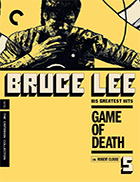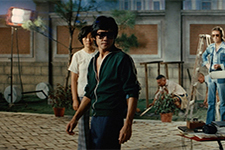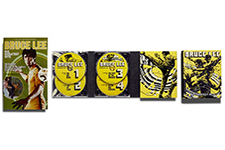| Director: Robert Clouse | | Screenplay: Jan Spears | | Stars: Bruce Lee (Billy Lo), Kim Tai-jong (Billy Lo), Yuen Biao (Billy Lo), Albert Sham (Billy Lo), Gig Young (Jim Marshall), Dean Jagger (Dr. Land), Colleen Camp (Ann Morris), Hugh O’Brian (Steiner), Robert Wall (Carl Miller), Dan Inosanto (Pasqual), Ji Han-jae (Restaurant Fighter), Kareem Abdul-Jabbar (Hakim), Mel Novak (Stick), Sammo Hung (Lo Chen) | | MPAA Rating: R | | Year of Release: 1978 | | Country: Hong Kong / U.S. |  |
|  There has never been a cinematic phenomenon quite like Brucploitation, in which dozens of low-budget films were churned out in the wake of martial artist Bruce Lee’s unexpected death at the height of his international stardom in 1973. These films didn’t just mimic his style, but purported in some twisted way to be actual Bruce Lee films. This was accomplished primarily by featuring martial artists with stage names like Bruce Li, Bruce Lai, Bruce Le, Tiger Lee, Conan Lee, Bruce Chen, and Bruce Thai who looked vaguely like Lee and could roughly approximate his martial arts skills. In some cases, the films appropriated footage of Lee himself, and many of them used Lee’s name in the title, such as Bruce’s Fingers (1976), Return of Bruce (1977) and The Clones of Bruce Lee (1979), while others were made to appear to be sequels to actual Lee films, such as The Big Boss Part 2 (1976), Fist of Fury Part 2 (1976), and True Game of Death (1979). As author Grady Hendrix described it, Brucploitation is “one of the tackiest acts of cinematic necrophilia you’ll ever see.” The best known of these Brucploitation films is Game of Death, which was released five years after Lee’s passing and was produced by Golden Harvest, the Hong Kong studio for which Lee made all his starring vehicles. It is also notable because, rather than simply utilizing Lee lookalikes (which it does) and slipping in quick insert shots of Lee himself (which it also does), the film features a lengthy sequence of climactic fights that Lee choreographed, performed, and directed for an unfinished film (also titled Game of Death). So, unlike so many Brucploitation films, Game of Death actually turns into a genuine Bruce Lee film in its final 15 minutes, and the change is palpable, as it suddenly goes from being an almost laughably inept approximation of what a Bruce Lee film might be like to the real deal. The moment Lee, clad in his now iconic yellow track suit with the black racing stripes, emerges from a stairwell and steps into frame, it is like the power suddenly flips on. When Warner Bros. approached Lee about starring in Enter the Dragon (1973), a unique U.S.-Hong Kong co-production that ultimately made Lee an international icon, he was already hard at work on Game of Death. Although the details of the film’s plot were not yet worked out, Lee knew it was to climax with his character working his way up the floors of a five-story wooden pagoda, each of which is guarded by a different adversary whose unique martial arts skills required Lee to adapt his own approach in order to be victorious. It was an ingenious setup as a structure for a series of fights, and it also allowed Lee to give cinematic form to his own belief about the importance of adaptability and flexibility in martial arts (something he had previously utilized in his epic fight-to-the-death against Chuck Norris’s Colt at the climax of 1972’s The Way of the Dragon). When Warner Bros. came calling, Lee had filmed the majority of three of the five intended fights (his adversaries were played by Filipino Eskrima master Dan Inosanto, Korean Hapkido master Han Jae Ji, and NBA star Kareem Abdul-Jabbar, who had studied kung fu under Lee in the late 1960s), giving him about 90 minutes of footage that he edited down to roughly half an hour. He set the project aside in order to make Enter the Dragon, but then died of a cerebral edemaone a month before its premiere. Thus, when Lee died, he left behind this partially realized project that had little hope of completion. Enter Robert Clouse, the director of Enter the Dragon, who collaborated (conspired?) with Golden Harvest to create an entirely different film onto the end of which Lee’s completed fight footage could tacked. Clouse cooked up a hammy script about a martial arts movie star named Billy Lo who is being muscled by a crime syndicate run by Dr. Land (Dean Jagger, a former Oscar winner clearly slumming it late in his career). After an attempted assassination during a movie shoot leaves him in the hospital with a bullet wound to his face, Billy fakes his own death (he doesn’t even tell his pop singer girlfriend, played by Colleen Camp) in order to enable him to better exact his revenge. (In a bit of unsettling coincidence, Lee’s son, Brandon Lee, was killed at the age of 28 on the set of the 1993 film The Crow when he was accidentally shot by a prop gun, the means by which Lee’s character is almost killed in Game of Death.) Billy is played at various points by three different Bruce Lee-esque performers: Korean taekwondo master Kim Tai-jong and Hong Kong martial arts actor Yuen Biao handle most of the fight and action scenes, while Albert Sham, usually wearing large, dark sunglasses, plays Billy in dialogue scenes and close-ups. Throughout the film Clouse and editor Alan Pattillo splice in various close-ups and reaction shots of Lee culled from his previous films, virtually all of which are more disruptive than anything, as they are dramatically different in style and quality (not only were Lee’s early films shot on lower quality film stock, but in some cases the shots were optically zoomed to move in closer to Lee’s face or to cut out the background or other characters, resulting in doubly exaggerated film grain). Without doubt the most risible moment is when the filmmakers employ a life-sized cut-out of Lee’s face pasted onto a mirror over the face of the actor playing Billy, although the appropriation of footage of Lee’s actual funeral, including a shot in which we briefly see Lee’s face inside the open casket, is some kind of pinnacle of bad taste. What is particularly tragic about Game of Death is that Lee wanted to use it to expand the potential of the action film. As he described in an interview, he wanted to open the film with an image of two trees in a snowstorm, the larger of which breaks in the wind due to its inflexibility while a small willow trees bends in the wind and survives. “It is the sort of symbolism,” he said, “which I think Chinese action films should seek to have. In this way I hope to broaden the scope of action films.” Clouse’s Game of Death, of course, did the opposite by appropriating Lee’s completed fight footage and awkwardly wedding it to a hackneyed plot in order to squeeze whatever profits could still be wrung from his legacy. It didn’t broad the action film, but rather fell back on convention and cliché, thus contributing to the steady decline of the martial arts film in the late 1970s. | Game of Death Criterion Collection Blu-ray |  Game of Death is available as part of The Criterion Collection’s Bruce Lee: His Greatest Hits boxset, which also includes The Big Boss (1971), Fist of Fury (1972), The Way of the Dragon (1972), Enter the Dragon(1973). Game of Death is available as part of The Criterion Collection’s Bruce Lee: His Greatest Hits boxset, which also includes The Big Boss (1971), Fist of Fury (1972), The Way of the Dragon (1972), Enter the Dragon(1973). | | Aspect Ratio | 2.35:1 (all films) | | Audio | Mandarin Chinese Linear PCM 1.0 monauralEnglish Linear PCM 1.0 monaural | | Subtitles | English | | Supplements | Audio commentary on The Big Boss by Bruce Lee expert Brandon BentleAudio commentaries on The Big Boss, Fist of Fury, The Way of the Dragon, and Game of Deathby Hong Kong film expert Mike LeederAudio commentary on the special-edition version of Enter the Dragon by producer Paul HellerHigh-definition presentation of Game of Death II, the 1981 sequel to Game of DeathGame of Death Redux, a new presentation of Lee’s original Game of Death footage, produced by Alan CanvanVideo interviews on all five films with Lee biographer Matthew PollyVideo interview with producer Andre Morgan about Golden HarvestVideo program about English-language dubbing with voice performers Michael Kaye and Vaughan SavidgeVideo interview with author Grady Hendrix about the “Bruceploitation” subgenre and a selection of Bruceploitation trailersBlood and Steel, a 2004 documentary about the making of Enter the DragonMultiple programs and documentaries about Lee’s life and philosophies, including Bruce Lee: The Man and the Legend (1973) and Bruce Lee: In His Own Words (1998) Video interview with Linda Lee Cadwell, Lee’s widowVideo interview with actor Jon T. BennVideo interview with actor Riki HashimotoVideo interview with actor Nora MiaoVideo interview with actor Jun KatsumuraVideo interview with actor Robert WallVideo interview with actor Yuen WahVideo interview with actor Tung WaiVideo interview with actor Simon YamVideo interview with director Clarence FokVideo interview with director Sammo HungVideo interview with director Wong JingAlternate opening credits and titles Alternate ending for The Big BossExtended scenes for The Big Boss“Bruce Lee: The Early Years” featurette“Bruce Lee vs. Peter Thomas” featurette The Legacy of the Dragon documentary “Bruce Lee Remembered” featurette The Grandmaster and the Dragon documentaryTrailers, TV spots, and radio spotsEssay by critic Jeff Chang | | Distributor | The Criterion Collection | | Release Date | July 14, 2020 | | | COMMENTS | | It may be hard to believe, but this is the first time all five of Bruce Lee’s starring vehicles have been collected into a single Blu-ray package, and Criterion has pulled out all the stops, giving us new high-definition transfers of all five films and hours upon hours of supplements that should keep even the most ravenous Bruce Lee fan satiated. Let’s start with the presentation of the films themselves: They were all transferred and restored in 4K, with the exception of the theatrical version of Enter the Dragon, which was done in 2K. The Big Boss and Fist of Fury were transferred from the original 35mm camera negatives, although the latter used a 35mm interpositive for the opening credits. The Way of the Dragon and Game of Death were transferred from 35mm internegatives, and Enter the Dragon was scanned from a 35mm interpositive. All of the films look better than they ever have on home video, as the new high-def transfers bring out additional levels of detail and texture that were missing in previous editions, as well as improved color timing that results in more natural looking flesh tones and stronger color saturation. Digital restoration has the films looking virtually flawless, with very few instances of dirt and wear. All in all, the films look great. The soundtracks were transferred from a variety of sources (including from materials held by a number of unnamed collectors), and while many of them (especially the early films) are certainly lacking in technical polish, they are reflective of the original aural experience and should be understood as such. And now, onto the supplements, which are … voluminous. How voluminous? Well, there are supplements on each of the discs for the five films and there are two separate Blu-rays just for supplements. I would be lying if I said I had watched and listened to every minute of it all, but I did get through a lot and would like to note some of the highlights. I really appreciated all of the audio commentaries. Each film features a track by Hong Kong film expert Mike Leeder. The Big Boss features an additional track by Bruce Lee expert Brandon Bentle, and the special edition version of Enter the Dragon features an additional track by producer Paul Heller. Each film also includes a video introduction by Matthew Polly, author of the recently published biography Bruce Lee: A Life and himself a practitioner of kung fu who was the first American to be allowed to study at the Shaolin Temple in China. There are hours of archival video interviews with Lee’s family and collaborators, including his widow Linda Lee Calwell and actors John T. Benn, Robert Wall, and Sammo Hung, among others. There are also some new interviews and programs, including a highly entertaining rundown on the Bruceploitation genre by author Grady Hendrix (along with 13 minutes of trailers for some of the more well-known Bruce Lee knock-offs), an engaging look at the history of Golden Harvest with producer Andre Morgan, and a fascinating program on dubbing the films into English with voice performers Michael Kaye and Vaughan Savidge. There are also multiple documentaries about Lee’s life and philosophies, including Bruce Lee: The Man and the Legend (1973), which weirdly and morbidly spends nearly half an hour on Lee’s death and funeral (all of the footage used in Game of Death appears here) and Bruce Lee: In His Own Words (1998). Other highlights include a high-definition presentation of Game of Death II, the 1981 sequel to Game of Death (not a good film by any means, but it is nice to have it hear for historical context) and Game of Death Redux, a new presentation of Lee’s original Game of Death footage produced by Alan Canvan. There are also alternate opening credits and titles for several films, as well as an alternate ending and extended scenes for The Big Boss. Throw in a making-of documentary about Enter the Dragon, a featurette on Bruce Lee’s early years, and tons of trailers, TV spots, and radio spots, and you have a package that can arguably be labeled as definitive. |
Copyright © 2021 James Kendrick Thoughts? E-mail James Kendrick All images copyright © The Criterion Collection |


 (1.5)
(1.5)

 Game of Death is available as part of The Criterion Collection’s Bruce Lee: His Greatest Hits boxset, which also includes The Big Boss (1971), Fist of Fury (1972), The Way of the Dragon (1972), Enter the Dragon(1973).
Game of Death is available as part of The Criterion Collection’s Bruce Lee: His Greatest Hits boxset, which also includes The Big Boss (1971), Fist of Fury (1972), The Way of the Dragon (1972), Enter the Dragon(1973). 